The town of Delphi nestles on the south slope of Mt Parnasus, and overlooks dramatic hillsides, acres of gray green olive groves and a small, sparkling-blue slice of Korinthiakos bay. It’s just plain, knock-your-socks-off beautiful.
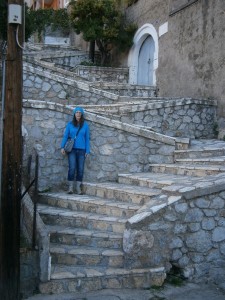
And this is only fitting, because back in the day, long before there were Greeks, Gaia, grandmother earth, had her sanctuary in this lovely spot and her child, the terrible Python, lurked underground. This was the time of the Titans. A time when the shadowy, frightful ghosts, gods, and spirits of the underworld reigned supreme.* Even then, legend has it that Gaia’s temple was a famous oracle.** And because it belonged to Her, it would have been the center of the earth, her belly-button or omphalos.
 And then, down from the big sky steppes of the north, came Zeus. He was a new and strange god. He had no form and no personality. He was huge and incomprehensible and He ruled the vast heavens. And He was definitely a he. This new kid on the block set about becoming top god in his chosen land. First, he established his mythological identity by insinuating himself into the existing pantheon as the son of Rhea and Cronos, the king and Queen of the Titans. Then he created the Olympian pantheon, which at first consisted of his brothers and sisters. This wasn’t enough, so he took is sister Hera as his queen and proceeded to populate the rest of the pantheon with his offspring. Since the Queen of the Gods was not as compliant as he would have wished, the only Olympians Zeus managed to father with Hera were Ares and Hephaestus. So he raped his cousin Leto
And then, down from the big sky steppes of the north, came Zeus. He was a new and strange god. He had no form and no personality. He was huge and incomprehensible and He ruled the vast heavens. And He was definitely a he. This new kid on the block set about becoming top god in his chosen land. First, he established his mythological identity by insinuating himself into the existing pantheon as the son of Rhea and Cronos, the king and Queen of the Titans. Then he created the Olympian pantheon, which at first consisted of his brothers and sisters. This wasn’t enough, so he took is sister Hera as his queen and proceeded to populate the rest of the pantheon with his offspring. Since the Queen of the Gods was not as compliant as he would have wished, the only Olympians Zeus managed to father with Hera were Ares and Hephaestus. So he raped his cousin Leto
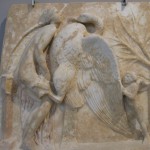
and fathered the twins, Apollo and Artemis. Dione, another aspect of grandmother earth, bore him Aphrodite (although this is only one version of her birth). Athena sprang full grown from her father’s brow (with a little help from Hephaestus), and Hermes was the result of his dalliance with the shy goddess Maia, daughter of Atlas. But Zeus didn’t stop there, he had a voracious appetite when it came to women and the numerous tales of his amorous exploits are offensive to most modern sensibilities.*** But I digress. Getting back to the omphalos, or center of my story:
Zeus’s infant son, Apollo, came north to the sanctuary of Gaia from his birthplace, the island of Delos in the Cycaldes, (or perhaps he came south from Thessaly bearing a laurel branch, depending on which myth you choose) and slew the mighty Python with his little bow and arrow. He left her to rot into the ground and claimed the sanctuary at Delphi for himself. His father, wanting, no doubt, to assure the universe that it was the Olympians who determined the center of the world, not the Titans, released two eagles, which flew around the earth and, wonder of wonders, met at Delphi, the physical center of Greece.
But the old gods still needed to be appeased.
Apollo was forced to flee and perform eight years of menial labor as atonement for his blood guilt, the slaying of Gaia’s child.****
The games that took place every four years to commemorate Apollo’s victory were called the Pythian Games, after the Python
The priestess of Apollo, who breathed the vapors of the earth, the pneumae, and spoke for him was called the Pythoness, or Pythia.
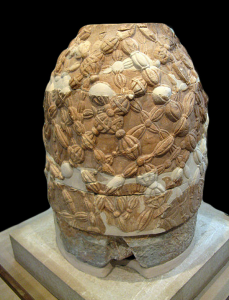
Sacrifices made at the Omphalos were made to the chthonic deities, the old gods. The Omphalos on display at Delphi today is probably a replacement of a replacement of the original. A knotted net is carved into its surface to represent the knotted filets of wool that were draped over the original. These filets were traditional sacrifices to chthonic gods and spirits. According to Jane Ellen Harrison (Chapter II, Prolegomena), the only reason anyone would dare to draw the attention of these entities is for the necessity of atonement or appeasement. The person doing the atoning wore knotted bands or filets of wool from the animal being sacrificed. This way the filets would have the energy of both the sacrifice and the person. The suplicant then laid the filets on the omphalos, or earth altar and their energy was consumed by the spirit or god being appeased. It was vengeance, not food that these deities and spirits craved. The original Omphalos was probably embedded in the earth and may even have been a channel for the Pythia’s trance inducing fumes. (it’s hollow) But, according to illustrations at the Museum at Delphi, it might later (possibly around 330BC) have removed from the earth and the Chthonic deities and elevated toward the sky and the Olympians on the 13 meter tall column of the dancers.
Delphi was indeed the physical, political, and cultural center of the Greek world. Grateful nations sent tithes to the oracle, which were stored in the dozens of treasuries that dotted the way to the temple of Apollo. The site was a definite moneymaker.
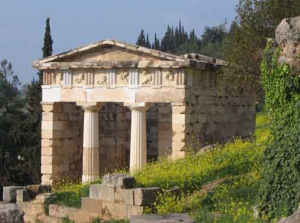
A theater that would seat 5,000 was built next to the Temple of Apollo, which became the Temple of Dionysius, Apollo’s alter ego, in the three winter months. Several important annual festivals and the Pythian Games were also held in Delphi.
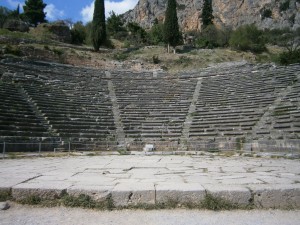
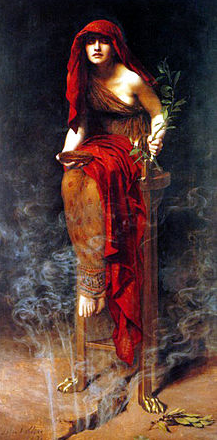
But the real reason for Delphi’s existence was the oracle. People from all over the Mediterranean came there for her advice. At the Pythia’s word, crops were planted, wars began, and history was made. As long as Gaia’s waters flowed under the sanctuary, sending up their trance inducing fumes, the money, prestige, and culture would continue to flow into the city. But eventually the waters stopped flowing. The site of Delphi is situated above two major fault lines, and every 100 years or so earthquakes shook the ground, stirring up the waters and releasing the entrancing hydrocarbon gases, but the earthquakes tapered off and the waters lost their kick. And so, when the Emperor Julian requested advice from the oracle in 363 AD his messenger was sent away with these words:
Tell the emperor that the great temple has fallen to the ground
Phoebus no longer has a shelter, nor a laurel diviner,
his spring of words does not babble, it has gone dry.
(Phoebus=Apollo)
Oddly enough, we know very little about the oracle herself. The Museum at Delphi is quite lovely and full of precious artifacts, but the only evidence of the Pythia that I remember in the museum was the occasional mention or picture of the tripod on which she sat. And there is no sign anywhere in the ruins that says with certainty, “This is where the Pythia sat and raved.” Most sources say that she probably sat over a vent located under the Temple of Apollo, or possibly on the main floor in the Adyton—the off limits part, or holy of holies.
A large chunk of rock called the Rock of the Sybil sits beside the road to the
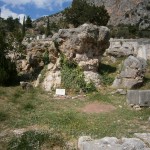
Temple. The sign beside it explains that the rock fell from the Phaedriadae, The Bright Ones, two cliffs which form a cleft in the mountain located above and to the east of the Temple of Apollo. This, it says, was where the first priestesses made their pronouncements, where the Sybil Hierophile foresaw the fall of Troy. (1400BC). A stone pool was built there centuries later where the Pythia cleansed herself before her trances and where supplicants and athletes performing in the games washed. Just hair washing was, usually sufficient, but murderers had to totally submerge. Today the pool is dry, but my husband remembers splashing in its shallow waters 40 years ago.
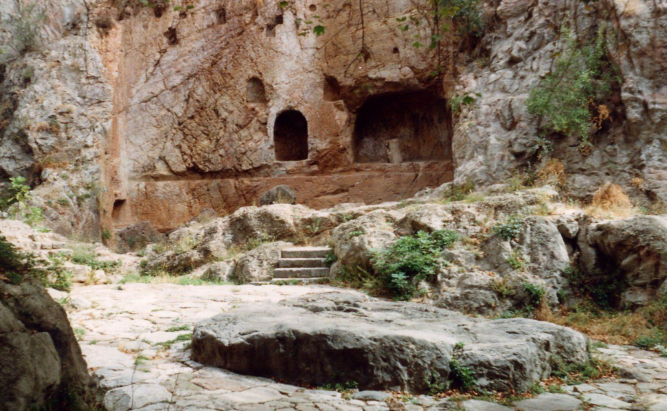
Delphi is an impressive and beautiful site, but there is a bittersweetness about it.
It reminds its visitors that, like the very earth beneath them, nothing is stable. Things shift. The Titans gave way to the Olympians who gave way to the Christian Church. The fabulous Greek civilization was conquered by the Romans who were eventually overrun by the barbarians.
The only constant is change.
* Prolegomena to the Study of Greek Religion, by Jane Ellen Harrison.
**Aeschylus, prologue of the Eumenides
***Zeus, a Journey through Greece in the Footsteps of a God, by Tom Stone, strings all the Zeus myths together into an authoritative and entertaining biography of the mighty Thunderer and the Olympians.
****Homeric Hymn to the Pythian


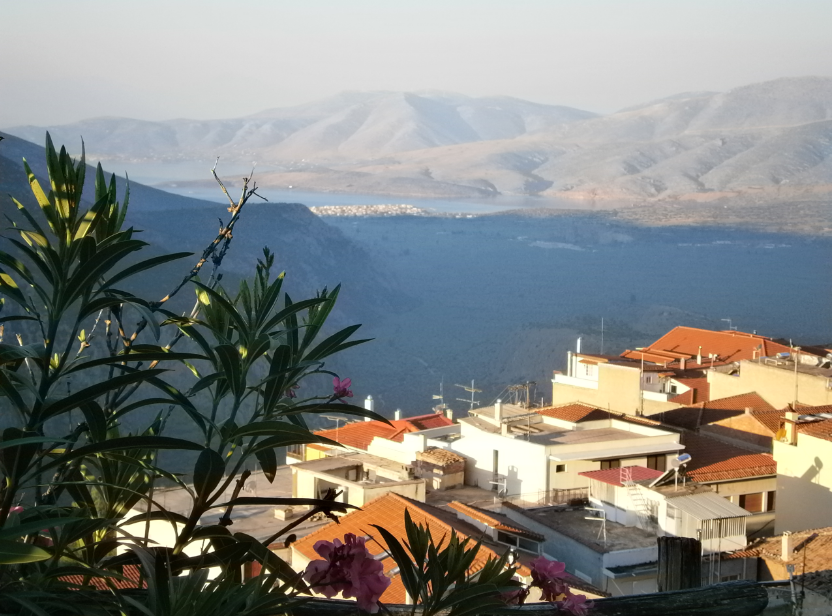
6 thoughts on “Delphi, Another Step in Our Greek Odyssey”
Love, love, love Delphi. We had many very magical adventures there!
I would love to hear about them.
We need to get together with you and Adam and trade Greece stories and pics.
Thank you!
I wish someone was paying me to write these posts, but they aren’t.
Like most other bloggers, they are a labor of love.
Thank you! Glad you enjoyed it.